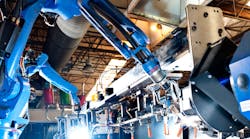Understanding, installing and monitoring advanced software and equipment is just part of meeting the challenge of the Industrial Internet of Things. There is also the basic issue of paying for this new technology.
Few today doubt that the IIoT won’t have significant financial benefits for manufacturers. In August 2015, McKinsey & Co. projected that “business-to-business applications will account for nearly 70% of the value that we estimate will flow from IoT in the next 10 years.” McKinsey said the IoT could generate as much as $11.1 trillion a year in economic value, with nearly $5 trillion coming from B2B settings, including factories.
There is also increasing evidence that manufacturers are buying into the need to invest in digitalization and advanced tooling. “Industrial manufacturing companies plan to invest 5% of annual revenue in digital operations solutions over the next five years,” according to a PwC survey of industrial manufacturing executives. PwC said more than a third of industrial manufacturing companies “report they have already reached an advanced level of digitization and integration and around three-quarters expect to be at such a level in five years’ time.”
A survey on automation investment published by MAPI in June 2016 found that 83% of manufacturers had “automated some part of their product-producing process in the five years prior to the survey” and 76% planned to make investments in the next three years.
The price for all this new technology won’t be cheap. A 2015 study by Strategy& of German industry reported that executives expect to spend a total of €40 billion on Industry 4.0 technologies every year through 2020. A similar level of investment throughout European industry, Strategy& said, would be as high as €140 billion per year.
Clearly, such wide involvement in new technologies indicates that the IoT revolution is moving beyond large IW 500 manufacturing companies. Small and medium-sized manufacturers, the vast bulk of the manufacturing sector, are also buying into this revolution.
“It is an investment they know they need to make,” says Gary Amos, a senior vice president with Siemens Financial Services. “We are hearing it with increasing frequency.”
Amos said SMEs often are “undercapitalized” and are looking for financial solutions that will help them invest now, even if the payoff may not be fully realized for several years.
Manufacturers are no longer restricted to traditional financing arrangements where they would pay for equipment over time and use their own personnel to monitor and service that equipment. Now a variety of purchase/service hybrid arrangements are available and, says Amos, financial executives are increasingly looking at a “fourth generation” of financing which looks “like a service contract by a service provider to a service user.”
Performance KPIs could be part of these contracts, says Amos, where a company agrees to a certain amount of uptime for equipment. If it fails to meet that goal, he notes, there could be a clawback provision that refunds part of the fee.
Amos believes these types of financing arrangements “will accelerate the market further in terms of Industry 4.0.”





